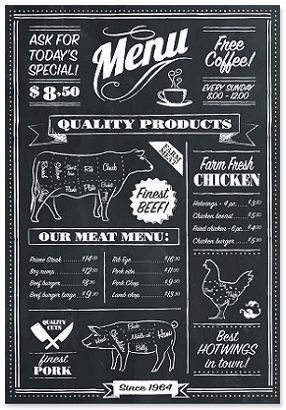According to a report, 60% of restaurants shut down within the first year of operations, and up to 80% of restaurants close their operations in the first five years. While there are no entry-level barriers to the restaurant industry, lack of business acumen, lack of management, and financial planning are some of the reasons why first-time restaurateurs fail. Thus, to ensure a restaurant business is well planned and successful, you must create a restaurant business plan beforehand.

Why is Business Plan Important?
69% of venture capitalists say that they have not invested in new ventures without reviewing a business plan first. It will show potential investors the viability of your business and provide them with a clear and interesting solution to the question, “Why does the world need this restaurant?”.
[blockquote author=”Charles Bililies, owner of Souvla”]You have to show any potential investor that you have an actual plan, you know what you’re talking about, it looks professional, and you’re not just screwing around.[/blockquote]
How to Write a Restaurant Business Plan?
A business plan creates a 30% greater chance of growth. Your business plan will serve as a roadmap for the development of your new restaurant.
Though drafting a business plan takes a lot of effort and time, it eventually clears out your vision on “How exactly would you run your restaurant business.” Creating a business plan should always be a top priority whether it’s your first or hundredth restaurant. Here are the key components to include in your business plan:
1) Executive Summary
An executive summary should always be the first section of a restaurant business plan. An executive summary serves as both an introduction to your business plan and a summary of the entire concept. The primary goal of an executive summary is to motivate the reader (often an investor) to read the rest of your business plan.
Elements of an executive summary:
- Mission statement
- Proposed concept
- Execution
- A brief look at potential costs
- Expected return on investments
2) Company Description
Begin this section by stating the name of the restaurant you are opening, as well as the location, contact information, and other pertinent information. Include the owner’s contact information as well as a brief description of their experience.
The restaurant’s legal position and short and long-term aims should be highlighted in the second section of the company description. Provide a brief market analysis demonstrating that you are aware of regional food industry trends and why the restaurant will prosper in this market.
Based on the “6 Ws” framework, the company description should answer:
- Who We Are: Describe yourself and the partners.
- What We Sell: The brief business concept and the target customer segment.
- Whom We Sell: Our target market/customers
- When: The timeline for the project, from build-out to pre-opening to grand opening.
- Where: Location/business premise.
- Why? Why do you think this concept is important and what are your hopes and dreams for the future? Do you envision expansion? Is franchising possible? Will you stick with one location?
3) Market Analysis
Investors would like to make a calculated risk when it comes to high-risk businesses like restaurants. The key here is to well-research all the important factors and come up with the most accurate data for the potential investors. The key components of market analysis are:
a) Industry Analysis
This section includes the current restaurant industry trends. Trends should be very specific to the current trends followed by the chosen demographic for the restaurant business.
b) Competition Analysis
What restaurants have already established a following in the neighborhood? Take note of everything, including the restaurant’s rates, hours, and menu design. Then describe how your restaurant will be unique to your investors.
c) Market Segmentation
Include a brief about the target market segment. Describe your target customers: Age, financial status, food preferences, etc. Your business plan should also give a brief about how exactly are you going to win the attention and loyalty of your target customers.
4) Sample Menu

You won’t be able to serve anything if you don’t have it. You probably don’t have a final version at this time, but for a restaurant business plan, you need at the very least to have a mock-up.
However, pricing should be the most important aspect of your sample menu. The cost research you’ve done for investors should be reflected in your prices. This will help them understand the intended price point for your restaurant. It will be extra points if you can show the estimated profitability per item within the sample menu!
5) Employees
51% of restaurant operators name staffing as a top challenge to success, and 35% say training staff is a top challenge. The investors don’t expect you to have assembled your full team at this point, but you should have at least a few people on board. Make the most of the talent you’ve chosen so far by emphasizing the overall job experience everyone brings to the table.
6) Restaurant Design
You may show off your thoughts and ideas to the investors in the design section of your restaurant business plan. That’s acceptable if you don’t have professional mock-ups of your restaurant rendered. Instead, create a mood board to communicate your goal. Look for images that have a similar aesthetic to what you want in your business.
7) Location
The location you choose for your restaurant should undoubtedly appeal to your target customers. You may not have a specific site in mind at this time, but you should have a few options. You want to give prospective investors as much information as possible about each potential location and why it would be ideal for your restaurant when you describe it to them. Include details such as square footage and usual demographics.
8) Marketing Plan
With restaurants springing up left and right these days, investors will want to hear how you plan to spread the word about your establishment. The marketing and publicity portion of your business plan should outline how you intend to market your restaurant both before and after it opens. As well as any intentions you may have to enlist the services of a public relations firm to help spread the news.
A marketing plan should enlist all the strategies adopted at every stage of the business. The key elements of the marketing plan should include:
a) Restaurant Website:
57% of the guests viewed restaurant websites before selecting where to dine. The website design along with logo and brand colors should be well planned for a restaurant business.
b) Social Media Management:
A survey determined that nearly half (45 percent) of U.S. diners said they’ve tried a restaurant for the first time because of a social media post made by the restaurant itself. Further, 22 percent said a restaurant’s social post enticed them to return.
[blockquote author=” – Ryan Goff, Executive Vice President, Social Media Marketing Director at MGH.”]For restaurant marketers, it’s clear that high-quality social media content, along with active engagement practices, still has great relevance to consumers.[/blockquote]
Social media marketing for a restaurant includes organic social media engagements, social media campaigns, social media ads, and executing loyalty programs digitally.
c) Digital PR:
Digital PR includes various activities to build brand awareness for your restaurants, getting listed in the local directories, managing reviews online, and getting your restaurant featured on various local blogs/publications.
9) Restaurant Financial Plan:
Considering the mandatory costs like- restaurant rent, insurance, permits, etc. The list of expenses is endless. The costs must include mentions like:
a) Start-up costs:
Mention every expense required to get your restaurant started: build-out costs, equipment cost, licenses and permits, architects fees, rent, insurance, and labor (pre-opening management salaries and training new staff before opening). You should add a 10% buffer to the total startup costs to account for contingencies.
b) P&L(Profit and Loss):
Add a revenue forecast with profitability for the next 3-5 years.
c)Additional Analysis:
Include a break-even analysis and cash flow projections in addition to the other analyses. They explain how you will break even (where your revenue covers your expenses) and show your expected cash flows
10) External Help
You’ll need a lot of aid to turn your restaurant idea into a reality. Make a list of any outside companies or software you intend to hire to help you get your restaurant up and operating. This includes anything from accountants and designers to providers who assist your restaurant in improving its performance, such as point-of-sale systems and restaurant reservation systems.
Need help setting up your restaurant? We are a click away!


